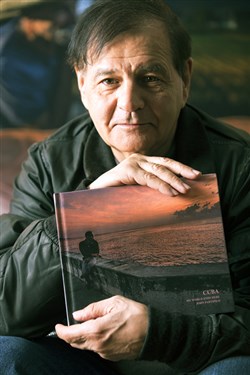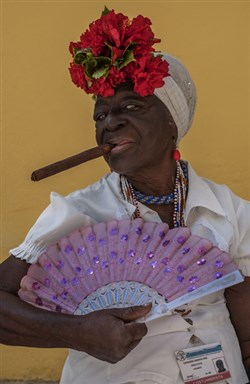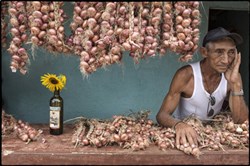VOL. 42 | NO. 13 | Friday, March 30, 2018
'He got in there and got pictures that no one else could have gotten'
By Colleen Creamer
Not everyone wants to be photographed. The homeless, gang members, certain religious groups, the disenfranchised, victims of crime and natural disaster, even the most private individuals among us.
The job of the photojournalist is to establish trust with the subject, to make a connection no matter what the circumstances. Few do that as well as John Partipilo.
The Nashvillian spent a decade in Los Angeles shooting for Time-Life, Newsweek, The New York Times and People Magazine. In 1998, he was lured from an Arkansas newspaper to Nashville to work as a staff photographer for the Tennessean.
Before attempting a photo series on the Mennonite population in Middle Tennessee, he knew he had to get permission first, as this is a group is not exactly fans of technology – or vanity.
“I will sit down with them and talk to them and put them at ease long before I pull the camera out because, seriously, photographers are not a normal thing in people’s lives. People trust me; that is how I get access,” Partipilo says, explaining his process.
Partipilo’s latest collection is a stunning, fine-art photographic essay from three trips to Cuba between May 2016 and March 2017. His work, “Cuba: My World Ends Here,’’ chronicles those trips.
Nashville Arts Magazine sponsored the photojournalist’s “Cuba work” as their artist of the week, displaying his work on the eye-catching billboard looming above the West End split.
Before concentrating on life in Cuba, Partipilo spent two decades photographing a mosaic of news, crime, trends, movers and shakers (and some ne’er do wells) – the spectrum that makes up the fabric and the zeitgeist of Middle Tennessee. He left his staff job at the Tennessean in 2015 to work on his own but not before making a name as a gifted chronicler of people and places, as well as being easy to work with.

Photographer John Partipilo holds his new book titled, "Cuba, My World Ends Here."
-- Michelle Morrow | The Ledger“Everybody wanted to work with him,” says Frank Sutherland, former Tennessean editor “There was no assignment he turned down and no assignment he didn’t enthusiastically go after. That was his personal commitment to the profession. He’s not just a photographer; he’s a journalist.”
Partipilo has two Pulitzer Prize nominations. His first was for a series on sharecropping for the Arkansas Gazette in the late 1970s. The second was a team nod to the Tennessean for the overall work the newspaper did on the historic May 2010 flood, during which Partipilo waded hip deep through muddy flood waters to capture the devastation.
Partipilo’s deeply human work packs the kind of emotional punch that words don’t convey; his image of a man weeping while navigating his neighborhood by canoe needs little explanation.
“The suffering I saw that devastated people’s lives will stay with me always,” Partipilo explains of the work on the flood, acknowledging not only the reporters but also the other photographers. “Everyone pretty much worked around the clock. I have never been that wet before. The Gore-Tex (a water repellant fabric) stopped repelling water after days of solid rain.”
The late Jim Ridley, the Nashville Scene’s longtime managing editor, wrote of Partipilo’s flood work: “During the flood, Partipilo functioned as witness, sentinel, recorder for posterity and signal flare. His wrenching photos from The Bottom – an impoverished and little-known community off Murfreesboro Road, where elderly African-American residents lost not only their living quarters but the wheel chairs that helped them get to shelter – opened eyes as well as wallets, and arguably saved lives.’’
Partipilo has a unique “origin story” on his passion for shooting – and probably truth-telling – that involves sneaking a Brownie Hawkeye camera into his Catholic elementary school in Illinois to document the spanking of the kids by the nuns.
See it up close
Nashville photographer John Partipilo’s solo fine art photography exhibition, Cuba: People in Transition, will be held at the O’More College of Design April 6-30.
The photographic display was curated by Beth Inglish.
The opening of the exhibit is April 6, 6-9 p.m., with an artist talk with Nashville Arts Magazine editor, Paul Polycarpou at 7 p.m.
Immediately following the talk, Partipilo will host a book signing for “Cuba: My World Ends Here,’’ a photographic essay of his two shooting treks to the island.
For nearly 60 years, only 90 miles off the coast of the United States, Cuba has been isolated from most Americans. "Cuba: People in Transition" is a photographic essay and an inside look into this long-shrouded country and the everyday life of its people. Information: www.johnpartipilocuba.eventbrite.com or Beth Inglish, [email protected], 615 739-2337.
The nuns, who confiscated the camera and the film, were not impressed with Partipilo’s sense of fair play, but his mother was. She urged him to continue to pursue whatever he was passionate about.
Partipilo is able to shoot and assemble images that are at once difficult to look at and nearly impossible to look away from. His style is photojournalistic, but his images fall under the category of fine art because of their level of technicality and artistic expression, color shots that are strong in composition and vibrancy, and black-and-white images so tonally rich they look as though they may have been done in an entirely different medium.
Always aware of his roots, Partipilo considers himself a “fine-art photographer who has a photojournalistic style.”
“Photojournalism is honest because you can’t, or at least you’re not supposed to, manipulate the image, so you have to learn quickly how to get all the elements in a millisecond, and you often have to do it without anyone knowing you are doing it,” he points out. “I don’t manipulate [my images] at all. I crop in camera on the spot.’’

Images from Cuba, submitted by John Partipilo
Partipilo’s six-month deep dive into the growing gang problem in Nashville for the Tennessean earned the veteran photographer Best of Photojournalism from the National Press Photographer’s Association and First Place from NPPA for Multiple Feature in 2011.
He pitched it and his editors gave him free rein.
That a number of gangs had been active in Middle Tennessee and recruiting in high schools took a lot of people by surprise, Partipilo remembers. He gained access to the gang Sur 13 when he befriended a female gang member while they were both in the back of a squad car. He was riding along with the Nashville Police Department’s gang unit, and she was heading to the station to answer some questions.
Partipilo handed her a bottle of water, knowing she was thirsty, and then slipped her his business card.
“She told me ‘They are never going to talk to you,’” Partipilo recalls. Later he would get a call that would open doors for him. Sutherland says Partipilo has a unique ability to gain access when access is difficult because of his approach.
“He got in there and got pictures that no one else could have gotten,” Sutherland adds. “There is access, and then there is access. It’s a skill that no one talks about much. He sat in on their inside sessions. I asked him if he was scared they would retaliate when they saw the story in the paper, and he said, ‘No. We are going to be cool.’ It took reportorial skills for him to get in there and to find out what was necessary to tell the story.”
Partipilo’s image from that series of a murdered African-American girl lying in an open casket with her mother leaning over her makes the viewer feel almost like an interloper; it is at once sad and intimate.
But Partipilo is rarely an interloper; his respect for his subjects is sincere, and they come to understand that.

Images from Cuba, submitted by John Partipilo
“The son was involved in a gang, and a gang member from another gang came to the door, and the daughter opened the door and he shot her apparently to punish the brother for some kind of gang-related transgression.” Partipilo recalls. “It was horrible. I was going to funerals once a week. A lot of kids were getting killed.”
He says he likes to stay in the background while out and observing until he sees a compelling shot.
“My process is like a Zen thing,” Partipilo says. “I sort of walk around and try not to think about it and just react to things that happen in front of me and, because I think that way, I think more serendipitous moments appear. I went to art school; I didn’t go to school for photography, so I still have concepts of art that I bring to this. I think that is why I see differently.
“Photojournalism is just a style of not posing pictures and trying to be more truthful and more real about things.”
It helps that Partipilo shoots every day, rain or shine, greatly enhancing his “luck,” his chances of being in the right place at the right time.
During two tours embedded with U.S. troops in Iraq in 2003 and 2004 for the Tennessean, Partipilo ate, flew and slept in blown-out buildings with the troops – and he almost got killed on the first deployment but not before he was warned, according to Sutherland.
“I sat him down beforehand and I said, ‘Look, no one has ever won a Pulitzer Prize for shooting a picture while they were getting shot at. Every war picture that won a Pulitzer Prize was about the devastation or the aftermath of battle or the anticipation of a battle. You are not to put yourself in danger.”
As Sutherland tells the story, Partipilo was traveling on a long caravan in Iraq when it came under fire. “Does he stay in the truck? No,” says Sutherland. “He gets out of the truck and starts shooting pictures.”
Partipilo’s version is similar – to a point.

Images from Cuba, submitted by John Partipilo
“That actually happened, but a lot of stuff happened,” Partipilo adds. “There were a lot of ambushes, but that is really just a reaction; that is what photographers do. When there are pictures going on, we are going to shoot pictures.”
His second deployment, his idea, was to embed with the 101st Airborne Division for a few months and then track them as they returned home, finally, to Fort Campbell.
“It was certainly emotional, but at the time I had no idea they were going to be deployed four more times,” Partipilo recounts. “You think a unit goes over there, and they do their thing, and they get some time off or they are deployed one other time, but at the time Bush was in charge. I think these guys got deployed like six times. At some point, you are thinking this coming home story doesn’t really work.”
Partipilo grew up in “mainly” in Arkansas and Illinois. He has sometimes been classified as a human-rights photographer based on his penchant for being in the right place at the right time as situations are heating up. He has chronicled the Women’s March, the anti-Trump movement, protests for and against DACA [Deferred Action for Childhood Arrivals] and the impact the 2008 housing crash had on the hungry and the homeless in Tennessee.
He shot a long-form series on rural Tennessee while working for the Tennessean. The six-month photographic essay documented the changing landscape of traditions in the hinterland. He found and covered working cowboys – willing to talk – functioning church congregations from previous centuries, the last wooden post office in Middle Tennessee, tobacco farmers who had gone out of business, and county fairs that have stayed just as they were in the Fifties. The series won a Gannett [the parent company of The Tennessean] Visual Journalist award in 2013.

Students Joshijah Spence, left, and Gabriella Karademosget get feedback from John Partipilo during a photo shoot. They are Partipilo’s students at Nossi College of Art.
-- Michelle Morrow | The Ledger“I found that some of these things are still going on and some are absolutely going away,” Partipilo explains. “I don’t know what it is about America – and I don’t think that Nashville is any different – but it amazes me that we let these traditions kind of go. I mean, you can kind of see these things that are historic that just get torn down in a single day. We have this disposable culture in America that I don’t think anybody really wants.”
Another project Partipilo lobbied for and brought to fruition for the Tennessean was “A Long Road,” a documentary on Ralph Meacham, one of the last sheep farmers in the region who was singlehandedly attempting to keep alive that sliver of the old ways and who let Partipilo track his daily life until the day he died from ALS.
“He was such a good guy,” Partipilo says. “One of the things I loved about shooting him is that he wanted me to do this so his family would have these photographs,” Partipilo recalls with some sadness. “So, I got complete access and literally covered him up until his funeral and his burial.”
The Mennonites, the homeless population of Tent City, families of those who have been murdered, Nashville’s Hispanic population, and the Kurds – Nashville has the largest Kurdish population in the U.S. – have all been subjects of Partipilo’s unearthing. The series on Middle Tennessee Kurds won Partipilo First Place from the National Print Photographers Association.
“I loved working with the Kurdish population because it really showed who they are; they are actually Indo-European,” Partipilo says. “We are America, a whole country of immigrants, and every group that comes here adds something to our culture.”
While on assignment for the story on the local Kurdish population, Partipilo met a Kurdish man who helped him on background for the story and who he later met up with when he was embedded in Iraq.
“Cozi Mohammed had been a janitor over at St. Thomas Hospital. Later he left America and went back to Iraq and worked with the Kurdish government,” Partipilo recalls. “So, in 2003 I got to see him. Some of the people I met doing the story on the Kurds went back to Iraq to translate. So, these guys owned restaurants here on Nolensville Road and gave up their business concerns to go over there.”
At Nossi College of Art’s Bachelor of Graphic Arts Commercial Photography program where Partipilo teaches, a class in photojournalism is required of all students whether they are preparing to do commercial work or investigative journalism because photojournalism requires students to be quick on their feet, Partipilo says. It can act as a bedrock.
“A few of them don’t want to take a photojournalism class because they don’t see the merit if they are going into another form of photography,” Partipilo says. “But I tell them ‘You are going to have to learn how to get out there and learn how to make people comfortable. You are going to have to learn not to take your camera out immediately.’”
Tom Stanford, photography coordinator at Nossi, says Partipilo gets his students out, and often, out of their comfort zone.
“We teach concept, and then we will go out and shoot it and practice it, so that plays to John’s strength,” Stanford says. “Not only can he teach the subject, but when he goes out the students learn because they can see in action how he interacts with people and how he communicates with strangers. For them, it’s pretty intimidating. He brings so much energy and enthusiasm that it rubs off on them. He was an excellent addition.”
Former student Kathleen Munkel, who was heading into a career in photojournalism when she took Partipilo’s class, says the spirit of the class was nearly as important as the letter of the class.
“He is so encouraging as a teacher,” Munkel says. “He has this vibrancy about him. He adores what he does, and he wants to share that. He brought out in me the range of what I can do, and he didn’t go easy on us; he pushed our talent. I soaked up everything he would say.”
Northern Spain’s Basque population, and their unique culture, is on Partipilo’s calendar for this coming spring. Partipilo may again find himself in the midst of some unrest when he heads there as the Basque, along with the Catalans to the east – who recently have urged their secession from Spain – have long wanted to be their own country, though that is not the reason he is going. The reason he is going is because he can.
“I think they [The Basque] get eclipsed somehow, but it’s a really an interesting culture because of the blending of French and Spanish,” Partipilo says.
“I am in the process of doing a lot of research, because I want to hit the ground running and not overthink things when I get there. I want to be present.’